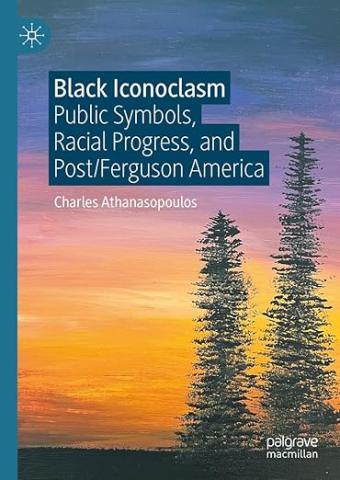
Dr. Charles Athanasopolous is an Assistant Professor in African American & African Studies and English at The Ohio State University. He graduated from our Ph.D program in 2022 and is about to have his first book published:
BlackIconoclasm: Public Symbols, Racial Progress, and Post/Ferguson America.
In the decade since the 2014 Ferguson Uprising, re-intensified conversations about racial progress continue to be at the forefront of American culture. The moniker Black Lives Matter, for example, emerged as a rallying cry of Black-led mass rebellions calling into question the rigid Western social codes of race, gender, class, and sexuality. These values emerge through iconography: those social codes reflected by a corresponding rolodex of public symbols (whether positive or negative) in American culture. Black Lives Matter fractured icons such as the first Black president, the innocent police officer, and the charismatic Black male activist, opening space for new theories and practices of Black radical disruption. At the same time, groups such as #BLM10, BLM Grassroots, and Mass Action for Black Liberation criticize the Black Lives Matter Global Network as having transformed into a new icon of racial progress, demonstrating that the meaning of Black liberation remains hotly contested. How do we discern Black radical thought and activism from the co-options of Western Man? Are we doomed to repeat a cycle of destroying a few icons only to inevitably produce new ones? In Black Iconoclasm, Charles Athanasopoulos dismantles the Eurocentric notion of iconoclasm as the physical destruction of icons and/or the recovery of supposedly pure counter-ideologies. Instead, Black iconoclasm refers to a liminal orientation toward cracks and fissures in narratives of linear racial progress and teleological narratives of Black liberation.
Athanasopoulos examines conflicting messages surrounding Black liberation in post/Ferguson America across activism, Black radical theory, communicative situations, cinema, and street art. Across each arena of American culture, his orientation toward the liminal unsettles the supposed cyclical nature of icons/iconoclasm by demonstrating that theories and practices of Black radical disruption always reflect both Black radical excess and the iconographic residues of Western Man. Those residues do not preclude those theories/practices from teaching us important lessons, they are how those lessons are learned to evolve our theories and practices of Black radical disruption. Institutional capture is neither simply inevitable just as no movement, person, or idea will be totally immune to Western Man’s racial icons. Thus, Black iconoclasm eschews purity politics and the pursuit of epistemological closure in favor of a critical orientation toward ritual transgression and Black radical discernment. Reframing iconoclasm in this way, Athanasopoulos opens avenues for new approaches to the relationship between Black resistance and the co-option of that resistance.
Endorsements
“Against the backdrop of urgent mandates to cultivate an abolitionist imaginary and discipline, Charles Athanasopoulos compassionately reminds readers to dwell in the twilight. In Black Iconoclasm, Athanasopoulos abides in the space of the liminal, the ritualistic, and the indeterminate to move against the registers of iconography and iconoclasm that often reside within Black radical traditions. Arranging and reading an eclectic set of texts for their fissures, messiness, and failures, Athanasopoulos attends to the everyday discursive, aesthetic, and material efforts to experiment outside of the orders and relations of Western Man. As a study of Black radical invention, Athanasopoulos elegantly writes toward and with traditions of Black fabulation that embrace the dexterities of Black experimentation, Black transgression, and Black critical theory.”
-Tiffany Lethabo King, author of The Black Shoals: Offshore Formations of Black and Native Studies
“Black Iconoclasm is a systematized intellectual program of theoretical disorder that reads widely across and in the crevices of Black Studies to provide an account of what is at stake for Black being at this present conjuncture. This book does the work of revealing the deep tensions and overlaps between what happens on the streets and in the academy and it warns us to pay closer attention to both as sites of potential Black liberation or further capture.”
- Rinaldo Walcott, Professor and Carl V. Granger Chair of Africana and American Studies, University at Buffalo
“In Black Iconoclasm: Public Symbols, Racial Progress, and Post/Ferguson America, Charles Athanasopoulos offers a cutting edge and timely exploration of how Black radical thought challenges and reframes the symbols of racial progress in the United States. Through innovative readings of contemporary activism and media, Athanasopoulos illuminates the complex interplay between iconoclasm and the persistence of racial iconography. This book is an essential contribution to understanding how Black resistance both disrupts and redefines the narratives of liberation in a post-Ferguson world.”
-Bernadette Marie Callafel, Indigenous, Race, and Ethnic Studies, University of Oregon
